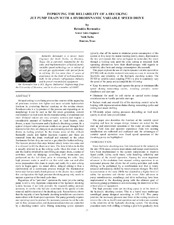| dc.description.abstract | Delayed coking is a refining process that consists of the upgrading of petroleum residues into lighter and more valuable hydrocarbon fractions by promoting thermal cracking on the residue stream. Petroleum coke is a by-product of this process and depending on its morphology it can be used as fuel for steam generation, cement calcination or as feed stock for the manufacturing of aluminum and steel. Delayed cokers are very complex systems and require a considerable amount of hardware such as fired heaters, coke drums, a main fractionator and a hydraulic decoking system. In a typical delayed coker petroleum residues are passed through fired heaters before they are charged, in an alternating fashion, into large drums as boiling product. In the drums some of this effluent thermally cracks into lighter fractions (vapors) and these are removed from the drum overhead and returned to the coker fractionator before they are sent to a gas plant for further refining. The heavier product that stays behind slowly forms into coke and it is allowed to fill the drum over time. This time is takes to do this is usually referred to as the coking cycle. Once the drum is full and the feed is switched to start filling an empty drum, a series of activities such as sludging, quenching and steam-outs are performed on the full drum prior to removing the ocke. Very high pressure water is used to cut this solid coke out and after some preparations this drum is empty and ready for a new coking cycle to begin again. As stated above, delayed coking is thus a combination of a continuous process through the fractionation tower and furnace and a batch process in the drums. As a result of this configuration the high pressure decoking pump only needs to operate a portion of the total cycle time. Regardless of its “part-time” operation the water jet coke cutting pump is still a very important component of the hydraulic decoking system because it not only provides the required cutting pressure necessary to cut the coke but also contributes to the quality of coke removed and the duration fo the decoking cycle. Recent history shows that the majority of new hydraulic decoking installations use electric motor drived with fixed speed operation. The pump generally requires on operating speed to produce the necessary pressure to cut the coke and its flow, pressurization, and depressurization duties are controlled by a decoking control valve. During noncutting cycles operators typically shut off the motor to minimize power consumption of the system or they keep the motor running (rarely done), depressurize the line and operate this valve on bypass to recirculate the water through a holding tank until the coke cutting is resumed. Both operating alternatives have their disadvantages with regard reliability (the first) and energy consumption (the second). This paper explores the use of a hydrodynamic variable speed drive (HVSD) with an electric motor-driven pump as a way to increase the flexibility and reliability of the hydraulic decoking system. The HVSD or variable speed coupling (VSC) is able to seamlessly vary the speed of the pump and accomplish the following: Keep the motor running and operate the pump at minimum idle speed during noncutting cycles, avoiding periodic motor shutdowns and start ups; Eliminate the need for soft starter or special motor design considerations to handle periodic start ups; Reduce work and extend life of the decoking control valve by helping with depressurization duties during noncutting cycles and cutting tool mode shifting; Efficiently adjust cutting pressures depending on feed stock quality to avoid coke pulverization. This paper also describes the function of the variable speed coupling and how its unique design features are suited for the start up and intermittent operation of the water jet coke cutting pump. Field data and operator experience from two existing installations are collected and evaluated and the advantages of variable speed operation over fixed speed operation of the decoking pump are highlighted. | en |


